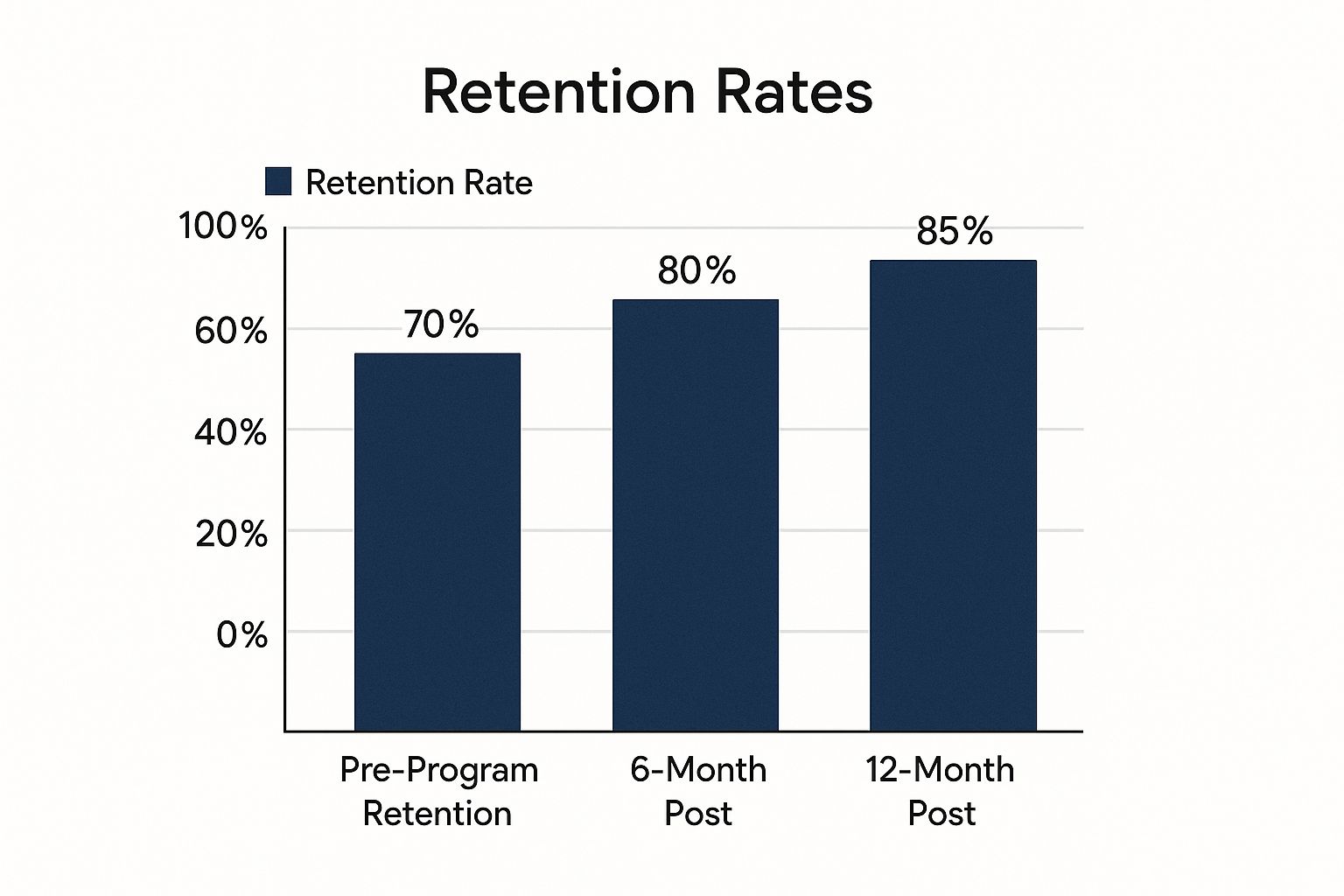How to Improve Employee Retention: Proven Strategies That Work

If you're serious about improving employee retention, the first step is to get brutally honest about what turnover is actually costing you. It’s not just about the obvious financial hits; it's the hidden, creeping costs that slowly drain your team's morale, productivity, and invaluable company knowledge.
The True Cost of Employee Turnover
Before you can even begin to plug the leak, you have to understand the size of the hole. Too many leaders underestimate the expense of turnover, thinking of it as a simple HR line item. The reality is that the costs ripple through the entire organization, hitting everything from project timelines to customer satisfaction. Thinking about how to improve employee retention demands a clear-eyed assessment of these losses.
The financial drain alone can be staggering when you add it all up. Replacing someone isn't just a matter of posting a job ad. It's a cascade of expenses.
- Recruitment Costs: Think about advertising fees, agency commissions, and the sheer number of hours your own team pours into screening resumes, conducting interviews, and vetting candidates.
- Onboarding and Training: A new hire represents a significant upfront investment. This isn't just the cost of formal training programs, but also the priceless time that managers and peers spend mentoring and bringing them up to speed.
- Lost Productivity: Every day a role sits empty, work either piles up or gets pushed onto other team members, risking burnout. And even when you hire someone, it can take months for them to reach the same level of productivity as the person they replaced.
Unpacking the Costs of Employee Turnover
To really see the financial incentive for retention, it helps to break down the specific expenses involved in replacing a single employee.
| Cost Category | Description | Example Financial Impact |
|---|---|---|
| Separation Costs | Expenses related to the departing employee, such as exit interviews, administrative tasks, and paying out unused vacation time. | $500 - $2,000 |
| Vacancy Costs | The cost of lost productivity while the position is unfilled, including overtime paid to other employees covering the workload. | $1,000 - $5,000+ per month |
| Recruitment Costs | All expenses to find and attract a new hire, including advertising, recruiter fees, background checks, and travel for interviews. | $3,000 - $15,000+ |
| Onboarding & Training | The cost of getting the new employee up to speed, from formal training materials to the time spent by managers and mentors. | $2,000 - $10,000 |
| Productivity Ramp-Up | The "cost" of a new hire operating at a lower productivity level until they are fully integrated and proficient in their role (often 6-12 months). | $10,000 - $25,000+ |
Seeing these numbers laid out makes it clear: investing in keeping your people is almost always cheaper than finding new ones.
The Hidden Impact on Your Business
Beyond the numbers on a spreadsheet, turnover inflicts deep, indirect wounds. When someone walks out the door, they take a piece of your company's brain with them. All that institutional knowledge—the undocumented shortcuts, the key client relationships, the internal network they used to get things done—vanishes. This loss can stall projects and create immense frustration for the people left behind.
High turnover acts like a slow leak in a tire. It might not seem critical at first, but over time, it drains momentum, destabilizes the team, and leaves you stranded. Addressing it is a business necessity, not an HR project.
This slow erosion of stability has become a massive concern for business leaders. Workforce volatility has firmly pushed retention from a "nice-to-have" HR initiative to a core operational priority. According to the U.S. Bureau of Labor Statistics, over 47 million Americans quit their jobs in 2021 alone, underscoring the scale of the challenge.
In fact, a recent survey highlighted that 66% of HR executives and over half of all operations leaders now see turnover as a primary obstacle to their business goals. You can dig into more of the data in this insightful employee retention report. This shift in thinking shows a growing recognition that a stable, engaged team is a powerful competitive advantage.
Ultimately, a revolving door of employees poisons your organizational culture. It becomes incredibly difficult to build the kind of cohesive, high-performing team that drives real success when you're constantly starting over.
Discover Why Your Best People Are Leaving

It's a frustrating and costly cycle: a great employee resigns, and you're left wondering what went wrong. The biggest mistake leaders make is guessing at the cause. We often jump to conclusions, usually pointing the finger at compensation. But just throwing money at the problem rarely stops the bleeding if the real issues are deeper.
To genuinely fix turnover, you have to get to the root of it. A data-driven approach is your best bet, combining a few different feedback methods to paint a complete and honest picture of your employee experience. This way, you stop chasing phantom problems while the real issues—the ones eroding your culture—continue to fester.
Go Beyond the Standard Exit Interview
The classic exit interview has its place, but let's be honest, it has flaws. When an employee is on their way out, they’re often guarded. They don’t want to burn a bridge, so you might get polite, filtered feedback instead of the unvarnished truth you actually need.
To get a clearer view, you need to be more proactive. I've found a couple of strategies to be incredibly effective:
- Anonymous Pulse Surveys: Think of these as a quick, regular health check for your company culture. Asking a few targeted questions monthly or quarterly gives you a real-time snapshot of employee morale and helps you spot brewing problems long before they turn into resignations.
- 'Stay' Interviews: This is a game-changer. Instead of only asking people why they leave, start asking your top performers why they stay. It's a powerful, forward-looking conversation that shows you exactly what you're doing right and which parts of your culture are most valuable to your best people.
Turn Raw Data Into Actionable Insights
Collecting all this feedback is just step one. The real magic happens when you connect the dots. Start digging into the survey results, the stay interview notes, and the exit interview transcripts. Are you seeing recurring themes? Maybe the same manager's name keeps popping up, or "lack of growth" is a phrase you see over and over.
This diagnostic work is where you save time and money. High turnover is incredibly expensive; Gallup estimates it can cost a company one-half to two times an employee's annual salary to find a replacement. Shockingly, studies show that about one-third of new hires quit within the first six months, often because the reality of the job didn't match their expectations.
Here’s a variable scenario: A company in the financial services sector was losing junior analysts and assumed it was a salary issue. Before overhauling their entire compensation structure, they ran anonymous surveys and stay interviews. The actual culprit? A complete lack of mentorship and no clear path for advancement. By implementing a new mentorship program and building defined career tracks, they solved the problem for a fraction of the cost of across-the-board raises. This approach can be adapted to various industries facing similar challenges with early-career talent.
According to a LinkedIn Learning Report, 94% of employees say they would stay at a company longer if it invested in their development, making a data-backed retention strategy a financial necessity. For a deeper dive, check out these insightful employee retention statistics.
Ultimately, this analysis ensures your retention efforts are laser-focused and effective. It can also shine a light on systemic problems you might not have noticed, like unconscious bias in your promotion process. If that’s a concern, learning how to start reducing hiring bias with evidence-based tools can help you build a fairer and more inclusive workplace from day one.
Invest in Your Team's Career Growth

Here’s a hard truth: if you don't have a plan for your employees' future, they'll find an employer who does. One of the most powerful things you can do to improve retention is to genuinely invest in your team's professional journey. When people see a clear path forward within your company, they stop being temporary contributors and start acting like partners in its success.
Stagnation is a huge reason talented people walk away. Most of us crave new challenges, new skills, and the feeling that our career is actually going somewhere. If you ignore this fundamental need, you’re practically inviting turnover. The fix is to build a development program that’s more than just a bullet point in a handbook—it needs to be a living, breathing part of your company culture.
Build Structured Career Paths
Ambiguity kills ambition. Your employees shouldn't have to guess what it takes to get to the next level. This is where career pathing comes in. It demystifies advancement by clearly outlining the specific skills, competencies, and experiences needed for each role and promotion. It’s all about creating transparency and giving people a tangible roadmap to follow.
Think about a mid-sized tech company struggling to keep its engineers. Instead of leaving it to chance, they could map out clear tracks:
- Junior to Mid-Level Engineer: Master specific programming languages, contribute to two major project releases, and show you can solve problems on your own.
- Mid-Level to Senior Engineer: Take the lead on a project feature, mentor a junior teammate, and get comfortable with system design.
- Senior to Principal/Lead: This step requires influencing architecture across teams, having a real track record of innovation, and speaking for the team in strategic talks.
Suddenly, career growth isn't just a vague hope; it's an achievable goal. This shows your team you're invested in their long-term success, not just what they can produce for you this quarter.
Launch Effective Learning and Mentorship Programs
If career pathing gives your team the map, then learning and mentorship programs are the vehicle. Offering skills-based training and mentorship gives employees the tools they actually need to move along that path. And no, this doesn't have to break the bank.
Imagine a retail business trying to cut down on turnover among its frontline staff. A simple but effective move would be to connect experienced store managers with high-potential associates in a mentorship program. This relationship provides priceless guidance, builds confidence, and forges a personal connection to the company's leadership.
The link between growth opportunities and loyalty is undeniable. When employees feel their company is investing in them, they reciprocate with commitment. A lack of career development isn't just a minor complaint; it's a major flight risk.
The data absolutely backs this up. According to Gallup, companies that make a strategic investment in employee development report 11% greater profitability and are twice as likely to retain their employees. What's more, organizations with strong retention strategies see a 22% increase in profitability. This is powerful proof that putting your people's growth first directly impacts the bottom line.
Investing in development also sends a strong signal about your company's values, which is a huge part of engagement. By figuring out which growth opportunities really connect with your team, you can tailor your efforts for maximum impact. For a closer look at this connection, you might find our guide on measuring employee engagement helpful to see how these initiatives boost morale.
Turn Your Managers Into Retention Champions

You’ve heard the old saying, "people leave managers, not companies." It’s a cliché for a reason—it’s largely true. A 2019 report by the HR professional association SHRM found that 57% of American workers said managers could benefit from training on how to be a better manager. Think about it: your frontline managers have more daily influence on an employee's happiness and engagement than anyone else in the building.
You can offer amazing perks and have a world-changing mission, but one bad manager can sour the entire experience, pushing a great employee out the door. This makes your managers your single most powerful asset in the fight against turnover.
But great managers aren't just born. They're made. Investing in their leadership abilities is one of the most direct investments you can make in keeping your teams happy and whole. The goal is to evolve them from simple taskmasters into genuine coaches who build loyalty from the ground up.
Equip Managers with the Right Tools
To become true retention champions, managers need a specific set of people skills. I'm not talking about abstract leadership theories, but practical, day-to-day abilities that build trust and make people feel valued.
Your training needs to focus on these core areas:
- Giving Constructive Feedback: Teach managers how to give feedback that helps people grow, not shrink. Instead of a vague critique like, "Your report was confusing," guide them to say, "Let's walk through the data section together. I think we can make the key takeaways stand out more for the execs." It's specific, collaborative, and focused on a solution.
- Practicing Real Recognition: Show them how to go beyond a generic "good job." Acknowledging the specific effort and its tangible impact is far more powerful. Something like, "Sarah, thank you for staying late to fix that bug. Your dedication saved us from a major headache with our biggest client."
- Building Psychological Safety: This is the bedrock of any high-performing team. Managers must learn how to cultivate an environment where people feel safe enough to speak up, admit mistakes, or pitch a wild idea without fear of being shamed or punished.
The Power of Consistent One-on-Ones
If there's one silver bullet in a manager's toolkit, it's the regular, meaningful one-on-one meeting. These aren't status updates. This is protected time that belongs entirely to the employee—a space for them to discuss their challenges, career goals, and overall well-being.
For a deep dive, this ultimate guide to one-on-one meetings is an incredible resource for structuring these conversations effectively. They are the best early-warning system you have for spotting retention risks before they become resignations.
A manager's role in retention isn't just managing tasks; it's about nurturing relationships. The quality of that manager-employee bond is one of the strongest predictors of whether someone will stay or go.
Finally, you have to hold managers accountable—fairly. This isn't about penalizing them every time someone leaves. It’s about making team turnover and engagement scores a recognized part of their performance review. This sends a clear signal that building a stable, motivated team is a core leadership responsibility, every bit as important as hitting project deadlines.
Cultivate a Culture of Genuine Appreciation
Let's be honest: feeling invisible at work is a one-way ticket to updating your resume. While a paycheck gets people in the door, it's feeling genuinely seen and valued that convinces them to stay for the long haul. When you build a culture where recognition is a daily habit—not just a line item in an annual review—you create a powerful reason for your best people to stick around.
The trick is to make appreciation feel real, not like some corporate-mandated "atta boy." People can sniff out forced, generic praise from a mile away. Real recognition connects an employee's specific contribution to a tangible business result, making it crystal clear that their work matters.
Go Beyond "Good Job"
It's time to move past the hollow "good job" and get specific. That's the difference between praise that's just heard and praise that's actually felt.
- Champion Peer-to-Peer Recognition: This is one of the easiest and most effective things you can do. Set up a dedicated "Props" or "Kudos" channel in Slack or Teams. It costs nothing and empowers teammates to celebrate each other's wins in real-time, building a powerful undercurrent of support.
- Leverage Leadership Shout-Outs: A personalized, handwritten note from a senior leader or a specific thank you during an all-hands meeting can have a massive impact on morale. It sends a clear message: great work gets noticed at every level.
- Celebrate the Small Wins: Don't wait for the massive project launch. Acknowledge the small victories that happen every day—squashing a tough bug, landing a great piece of client feedback, or helping a colleague who was swamped. These small moments are what sustain momentum and keep people engaged.
The numbers don't lie. Companies that are intentional about recognizing their people simply perform better. In fact, research from Gallup shows that recognition not only boosts individual engagement but can also improve productivity and loyalty to the company, ultimately lowering turnover.
Make Recognition Part of Your Company's DNA
To truly make a difference, appreciation has to be baked into your company's operating system. It should be a natural part of your meetings, your internal communications, and your one-on-one check-ins. When it’s consistent, recognition stops being a special event and becomes a cultural cornerstone.
This is a fundamental step in building a culture of excellence where people feel connected to the mission and to each other.
Choosing the right mix of recognition strategies is key. Some have a bigger impact than others, and they all come with different levels of effort and cost.
Comparing Employee Recognition Strategies
| Recognition Strategy | Implementation Effort | Relative Cost | Potential Retention Impact |
|---|---|---|---|
| Peer-to-Peer "Kudos" Channel | Low | None | High |
| Leader-Led Public Praise | Low | None | High |
| Handwritten Thank-You Notes | Medium | Low | Very High |
| Small Spot Bonuses/Gift Cards | Medium | Low-Medium | Medium |
| Experience-Based Rewards | High | Medium-High | Very High |
| Annual Awards/Ceremonies | High | High | Low-Medium |
As you can see, some of the most impactful strategies are also the most affordable. A well-rounded approach often combines a few of these methods to ensure everyone feels valued in a way that resonates with them.

The data in this chart drives the point home. A structured recognition program isn't just a "nice-to-have." As shown, it can directly lead to a significant, sustained lift in employee retention. When people feel seen and appreciated, they invest back into the company with their loyalty and best work.
Answering Your Top Retention Questions
As you start getting serious about employee retention, the "what-if" scenarios and practical questions start piling up. It's one thing to talk about theory, but it's another to put it into action. Let's tackle some of the most common questions I hear from leaders trying to build a team that sticks around.
How Can a Small Business With a Limited Budget Improve Retention?
I get this one all the time. The good news? You don't need a massive budget to make a real difference. For small businesses, it's all about low-cost, high-impact strategies that create a foundation of trust and respect. Forget the expensive perks for a moment and focus on the quality of the daily employee experience.
Here’s where you can concentrate your energy:
- Consistent Communication: Keep your team in the loop. Make sure your leadership is transparent and genuinely accessible.
- Clear Growth Opportunities: People need to see a future. Create paths for advancement, even if they aren't straight-up promotions. This could be mentoring a junior team member or taking the lead on a new project.
- Manager Empowerment: Your managers are on the front lines. Train them to give feedback that actually helps and to offer genuine, specific recognition.
- Flexibility: This is one of the most powerful, low-cost benefits you can offer. A 2022 survey by FlexJobs found that 57% of workers would look for a new job if their company took away remote work options, highlighting the high value placed on flexibility.
Think about it: a simple peer-to-peer praise system in your team's chat channel costs absolutely nothing but can do wonders for morale. It makes people feel seen and appreciated.
Is Salary Still the Most Important Factor?
Competitive pay is the price of admission. It gets you in the game. If your salaries are way below the market rate, you’ll have a retention problem that no amount of free pizza can fix.
But once you meet that fair salary threshold, other things become much more important.
Research shows this time and time again. A 2021 survey by the Pew Research Center found that while low pay was a top reason for quitting (cited by 63% of respondents), a lack of opportunities for advancement (also 63%) and feeling disrespected at work (57%) were equally significant drivers of turnover.
You simply can't throw money at a bad culture and expect it to get better. The winning formula is combining fair pay with an exceptional employee experience. And to make sure your team gets quick, accurate answers about their compensation and benefits, consider the advantages of improving human resources with custom trained AI chatbots.
How Long Does It Take to See Results?
This is where patience and consistency become your best friends. You won't see your turnover rate drop overnight, but you can see positive changes in your leading indicators much sooner.
For instance, within 3-6 months of launching new manager training or recognition programs, you might notice an uptick in your employee engagement scores or hear more positive feedback during one-on-ones. Those are the early signs that things are moving in the right direction.
A measurable drop in your actual turnover rate—a lagging indicator—will take longer to show up, usually somewhere in the 6-12 month range. The trick is to track both. Watching the leading metrics gives you confidence that your efforts are working long before the lagging metrics catch up. Rebuilding trust and shifting a culture takes time, so stick with it.
Ready to stop guessing and start building a culture that keeps your best people? MyCulture.ai provides the tools you need to assess cultural alignment, identify retention risks, and develop your team with data-driven insights. Request a demo today.